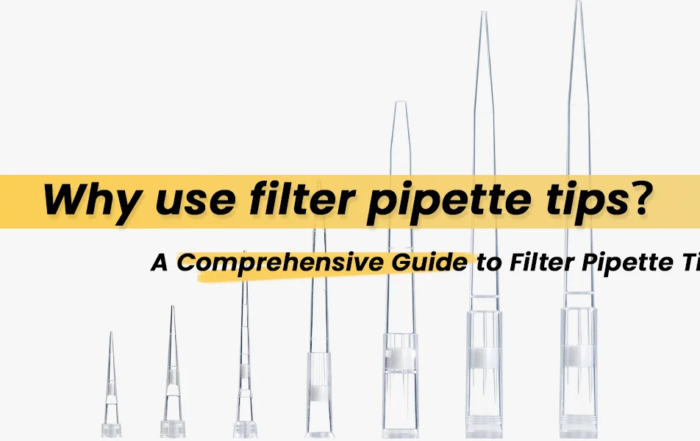Table of Content
The precision of pipettes depends on the choice of pipette tips. It is important to understand that even the best-calibrated pipettes may go wrong due to inappropriate tips. Furthermore, unsuitable tips can result in:
- Contamination of fluid samples used during experiments.
- Wastage of samples and reagents.
- Physical harm due to repetitive stress injury (RSI).
Choosing a high-quality pipette tip is important to:
- Maintain maximum accuracy.
- Prevent experimental errors.
- Minimize the amount of air that is drawn due to the space between the pipette and its tip. This may result in incorrect aspiration of the liquid.
Let us now understand the different types of pipette tips.
1. Universal or Pipette-Specific Tips
Universal tips are suitable for almost all types of pipettes available in the market. Though these pipette tips may differ slightly in diameter (based on the manufacturer), they are designed to fit securely around all types of pipette barrels.
The incorporation of additional capabilities like FlexFit technology makes universal pipette tips flexible at their proximal end. This makes them suitable for use with a wider range of pipettes while delivering accuracy.
On the other hand, pipette-specific tips are manufactured to suit particular types and sizes of pipettes that cannot be used interchangeably.
2. Non-Barrier and Barrier or Filter Tips
Non-barrier tips are used for daily lab work. It is recommended to use a barrier or filter tip if the pipetting involves solutions like corrosive, volatile or viscous chemicals that may contaminate the pipette.
Barrier tips are filtered tips that protect the pipette from aerosols and aspirating volatile solutions. These pipette tips are pre-sterilized and DNase/RNase-free. These filter pipettes are ideal for sensitive applications like qPCR. The role of this filter involves filtering the sample residue and preventing contamination.
Barrier tips also come handy when the fluid is accidentally aspirated into the pipette. In such cases, barrier tips enable the replacement of the pipette tip rather than the entire pipette.
Non-barrier pipette tips are used for non-sensitive applications. They can be used in applications that involve plasmid DNA or gels. These pipette tips are also less expensive.
3. Low Retention Pipette Tips
These pipette tips retain a low level of the liquid. Standard pipette tips always have some amount of liquid left after dispensing the pipetting solution. Low retention tips come with a hydrophobic plastic additive that keeps the liquid from remaining inside the tip.
4. Extended Length Tips
They enable access to the bottom of the flasks, reagent bottles, and test tubes. These tips have an extended length that prevents the pipette’s shaft from touching the inner side of the vessel containing the sample. This adds a layer of security and protects samples from getting contaminated.
5. Solvent-Safe Carbon Filtered Tips
These tips are best suited for bases, acids, and aggressive organic solvents. Carbon ART filtered tips offer protection against the destructive residue of aerosols and vapors without compromising on the pipetting accuracy.
A few other features to look for in pipette tips are:
a. Graduated Tips
These tips have graduations on their side. They help users check if the volume of liquid has reached the same reading on the tip each time to ensure accuracy. They also help in maintaining standards of the pipetting technique.
b. Ergonomic Tips
Ergonomic tips save people from repetitive stress injury (RSI). These tips need lower insertion and ejection forces that result in reduced risks of RSI. They attach and detach smoothly, which further contributes towards reducing the force needed to handle it.
How to Use a Pipette Tip?
- Ensure that the pipette tip is the correct size and creates an airtight seal.
- Tips should not be attached forcibly. They should automatically attach with an airtight seal.
- Every pipette should be attached to a pipette tip when in use.
- Pre-rinse the pipette tip and then aspirate the solution into the tip. Dispense the liquid. Pre-rinsing will help overcome errors in calibration due to different wetting capabilities of liquids.
Wrap Up
Pipette tips play an important role in improving the accuracy of pipetting procedures. They also help control contamination and protect pipettes from suffering damages. We hope the above-listed pipette types have provided an outline to help you select the best-suited pipette tip for your pipette type.
Recent Posts
Earth Day in the Lab: GenFollower’s Eco‑Driven Innovations for Sustainable Science
What is Earth Day? Earth Day began in the United States in the early 1970s, when a burgeoning environmental movement on college campuses sought to awaken public consciousness towards the fragility of our planet. [...]
What is Cell Therapy Manufacturing?Essentials and manufacturing processes for cell therapies
Cell therapy is rewriting the rules of modern medicine. Imagine a treatment that uses a patient’s own immune cells, reprogrammed in a lab to hunt down and destroy cancer—this is no longer science fiction [...]
Why use filter pipette tips? A Comprehensive Guide to Filter Pipette Tips
In laboratory workflows, unseen threats like aerosol contamination, residual liquid carryover, and cross-contamination can silently sabotage experimental results. This is where filter pipette tips step in—not just as disposable tools for liquid handling, but [...]



